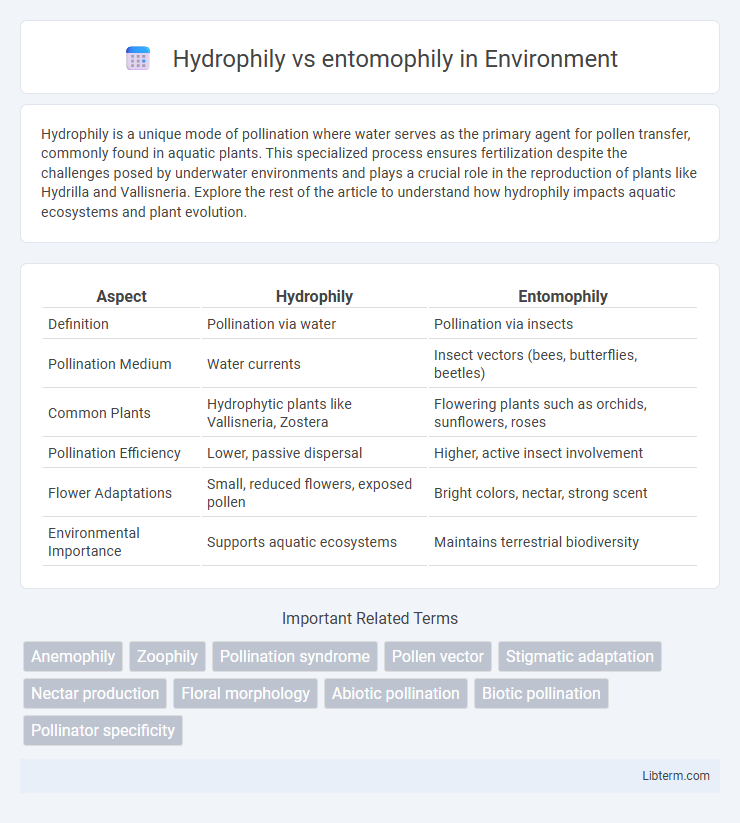Hydrophily is a unique mode of pollination where water serves as the primary agent for pollen transfer, commonly found in aquatic plants. This specialized process ensures fertilization despite the challenges posed by underwater environments and plays a crucial role in the reproduction of plants like Hydrilla and Vallisneria. Explore the rest of the article to understand how hydrophily impacts aquatic ecosystems and plant evolution.
Table of Comparison
| Aspect | Hydrophily | Entomophily |
|---|---|---|
| Definition | Pollination via water | Pollination via insects |
| Pollination Medium | Water currents | Insect vectors (bees, butterflies, beetles) |
| Common Plants | Hydrophytic plants like Vallisneria, Zostera | Flowering plants such as orchids, sunflowers, roses |
| Pollination Efficiency | Lower, passive dispersal | Higher, active insect involvement |
| Flower Adaptations | Small, reduced flowers, exposed pollen | Bright colors, nectar, strong scent |
| Environmental Importance | Supports aquatic ecosystems | Maintains terrestrial biodiversity |
Introduction to Plant Pollination Mechanisms
Hydrophily and entomophily represent distinct plant pollination mechanisms adapted to aquatic and terrestrial environments, respectively. Hydrophily involves the transfer of pollen through water, primarily seen in submerged or floating aquatic plants such as Vallisneria and Zostera, whereas entomophily relies on insects like bees, butterflies, and beetles to carry pollen between flowers, a process critical for many angiosperms including apple, sunflower, and orchid species. Understanding these specialized pollination strategies reveals the evolutionary adaptations enabling reproductive success across diverse habitats.
Defining Hydrophily and Entomophily
Hydrophily refers to the pollination process where pollen is transferred through water, typically occurring in aquatic plants like Vallisneria and Hydrilla. Entomophily describes pollination carried out by insects such as bees, butterflies, and beetles, crucial for many terrestrial flowering plants including orchids and sunflowers. Both hydrophily and entomophily represent specialized pollination mechanisms adapted to distinct environmental conditions.
Key Differences between Hydrophily and Entomophily
Hydrophily is a water-mediated pollination process where pollen is transported by water currents, primarily in aquatic plants, while entomophily involves insect pollinators transferring pollen to facilitate fertilization in a wide variety of terrestrial plants. Hydrophily relies on pollen grains that are often smooth and light to float on water surfaces or submerged environments; entomophilous plants typically produce sticky or barbed pollen to attach firmly to insects like bees, butterflies, or beetles. The ecological niches differ significantly, with hydrophily restricted to aquatic habitats and entomophily widespread in diverse terrestrial ecosystems, reflecting adaptations for maximizing reproductive success in distinct environments.
How Hydrophily Works: Pollination Through Water
Hydrophily is a specialized form of pollination where pollen grains are transported through water, primarily in aquatic plants such as Vallisneria and Hydrilla. Unlike entomophily, which relies on insects, hydrophily involves either surface pollination, where pollen floats on the water surface, or subaqueous pollination, where pollen moves underwater to reach the female reproductive organs. This adaptation ensures reproductive success in aquatic environments by utilizing water currents for effective pollen dispersal.
How Entomophily Works: Pollination by Insects
Entomophily involves pollination through the transfer of pollen by insects such as bees, butterflies, and beetles, which are attracted to flowers by bright colors, scents, and nectar rewards. These insects collect pollen on their bodies while feeding on nectar, inadvertently depositing it onto the stigma of other flowers, facilitating cross-pollination and genetic diversity. Entomophilous plants often exhibit specialized floral structures like landing platforms and nectar guides to optimize pollinator efficiency and ensure successful reproduction.
Plant Adaptations for Hydrophilous Pollination
Hydrophilous pollination involves plant adaptations such as floating pollen grains resistant to water immersion and filamentous pollen structure to enhance buoyancy and water dispersal. Hydrophilous plants often exhibit reduced or absent petals and stigmas designed to capture pollen from water surfaces or submerged conditions. Unlike entomophily, which relies on insect pollinators, hydrophilous pollination adapts to aquatic environments through specialized reproductive morphology optimized for waterborne pollen transfer.
Floral Traits Favoring Insect Pollinators
Floral traits favoring insect pollinators include bright colors, strong fragrances, and nectar rewards that attract entomophilous species such as bees, butterflies, and beetles. Flowers adapted for entomophily often have specialized structures like landing platforms and nectar guides to facilitate insect visitation and efficient pollen transfer. Unlike hydrophilous flowers, which tend to be reduced and lack attractive features, entomophilous flowers evolve conspicuous traits to enhance pollinator attraction and ensure reproductive success.
Ecological Significance of Hydrophily and Entomophily
Hydrophily, pollination through water, plays a crucial ecological role in aquatic ecosystems by enabling reproduction of submerged plants like Vallisneria, ensuring genetic diversity and habitat stability. Entomophily, the pollination by insects such as bees and butterflies, is vital for terrestrial plant species, promoting cross-pollination and supporting biodiversity in various ecosystems. These two pollination mechanisms maintain ecological balance by facilitating plant reproduction in distinctly different environments, thereby sustaining food webs and ecosystem services.
Examples of Hydrophilous and Entomophilous Plants
Hydrophilous plants, such as Vallisneria and Hydrilla, rely on water for pollination by transporting pollen grains through aquatic environments. Entomophilous plants, including roses (Rosa spp.) and sunflowers (Helianthus annuus), depend on insects like bees and butterflies to transfer pollen from one flower to another. Both pollination strategies enhance reproductive success in their respective habitats by optimizing pollen dispersal mechanisms.
Comparing Efficiency and Evolutionary Impacts
Hydrophily exhibits lower pollination efficiency due to water's limited ability to transport pollen accurately, resulting in higher pollen wastage compared to entomophily, which relies on insects for targeted pollen transfer. Entomophily has driven co-evolutionary adaptations such as flower coloration, scent, and nectar rewards, enhancing reproductive success and species diversification. In contrast, hydrophily represents a more primitive pollination mode with less specialized plant structures, reflecting adaptations primarily to aquatic environments rather than diverse ecological interactions.
Hydrophily Infographic

 libterm.com
libterm.com